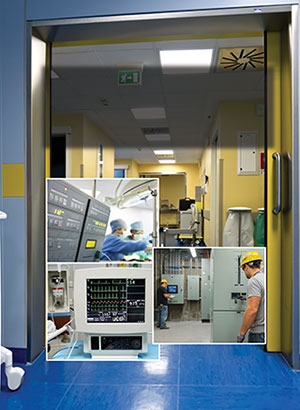Hospital safety has come a long way over the last decade. The advancements in medicine and medical procedures have saved the lives of millions. But hospital safety advancements aren’t limited just to doctors, nurses and EMTs. In fact, improvements to national fire and safety codes have done wonders to minimize hazards and risks to patient, staff and visitors in health care facilities.
Most notably, with new electrical technologies on the market aimed at making health care facilities safer, the National Fire Protection Association® (NFPA) has followed suit with its code specifications. The most recent iteration of the NFPA 99: Health Care Facilities Code specifically addresses the safety requirements for the performance, maintenance and safe practices in health care facilities.
While most health care facility managers have a general understanding of previous iterations of NFPA 99, the latest edition, drafted in 2012, was completely rewritten, meaning that even those who had deep knowledge of prior versions would need to learn how this new document was restructured and what it actually means to all those affected. Prior to 2012, NFPA 99 was simply called a Standard, which essentially means it was a “best practices” manual, whereas the new edition is actually called a Code – meaning it can now be adopted into law and legally enforced. The second major point of differentiation is the shift from occupancy based to risk-based approach. Facility managers are finding that this completely changes the way a facility is evaluated, and how all systems are designed and built into that facility.
In speaking with many in the field, the same themes keep coming to the surface: Help us better understand exactly what this code means and inform us of the proper solutions that will not only bring our facility up to code, but maximize the safety for everyone inside.
So as health care facility managers look to bring their facilities up to code, it is imperative that a higher level of understanding and education is established to ensure proper usage of new technologies. This is where electrical device manufacturers need to step up and do our part.
With a suite of products at their disposal to improve safety and efficiency, health care facility managers must understand where and in what applications these solutions are most applicable. From hospital grade arc-fault circuit interrupter (AFCI) receptacles that prevent fires from electrical wiring to ground-fault circuit interrupter (GFCI) receptacles that protect from electrocution in wet or damp areas to surge protective devices for protecting sensitive electronic and emergency equipment, safety solutions vary greatly and require the necessary education for compliance and effectiveness.
Several manufacturers joined forces with NFPA to educate industry professionals — everyone from health care facility managers to engineers to architects — on the specifics of the code and help identify available solutions to reduce risk. We conducted a series of interactive seminars around the country, presented by certified NFPA instructors, aimed at eliminating the confusion as approaches to this code switch from occupancy to risk-based. We also cover electrical systems and equipment, features of fire protection, risk assessment and process of code development and enactment.
While medical personnel are busy saving lives, ensuring the safety of everyone who enters a health care facility from potential fire and electrical shock risk should be of the utmost importance of everyone involved in the management of the facility.
This is a joint effort that requires cooperation from all interested parties. With countless options available, it’s the education that sets apart the most successful health care facility managers and spec engineers from their peers.
Take the time to learn all you can about the code requirements and the solutions that not only meet but exceed the requirements to safeguard your facility from safety issues now and into the future.











Find Us on Socials